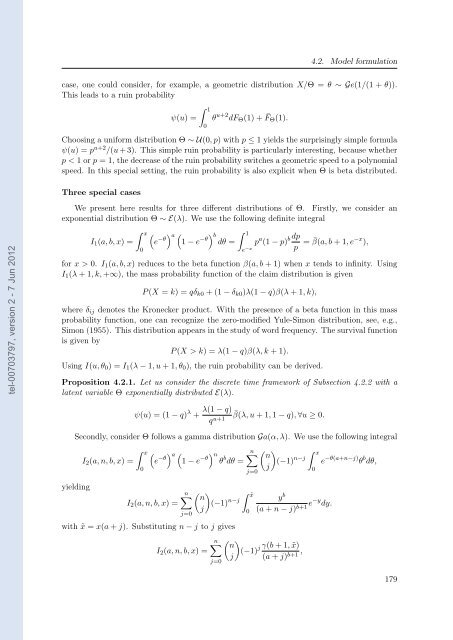Etude des marchés d'assurance non-vie à l'aide d'équilibres de ...
Etude des marchés d'assurance non-vie à l'aide d'équilibres de ...
Etude des marchés d'assurance non-vie à l'aide d'équilibres de ...
You also want an ePaper? Increase the reach of your titles
YUMPU automatically turns print PDFs into web optimized ePapers that Google loves.
tel-00703797, version 2 - 7 Jun 2012<br />
4.2. Mo<strong>de</strong>l formulation<br />
case, one could consi<strong>de</strong>r, for example, a geometric distribution X/Θ = θ ∼ Ge(1/(1 + θ)).<br />
This leads to a ruin probability<br />
ψ(u) =<br />
1<br />
0<br />
θ u+2 dFΘ(1) + ¯ FΘ(1).<br />
Choosing a uniform distribution Θ ∼ U(0, p) with p ≤ 1 yields the surprisingly simple formula<br />
ψ(u) = p u+2 /(u + 3). This simple ruin probability is particularly interesting, because whether<br />
p < 1 or p = 1, the <strong>de</strong>crease of the ruin probability switches a geometric speed to a polynomial<br />
speed. In this special setting, the ruin probability is also explicit when Θ is beta distributed.<br />
Three special cases<br />
We present here results for three different distributions of Θ. Firstly, we consi<strong>de</strong>r an<br />
exponential distribution Θ ∼ E(λ). We use the following <strong>de</strong>finite integral<br />
x <br />
I1(a, b, x) = e −θ a <br />
1 − e −θ <br />
b 1<br />
dθ =<br />
e−x p a b dp<br />
(1 − p)<br />
p = ¯ β(a, b + 1, e −x ),<br />
0<br />
for x > 0. I1(a, b, x) reduces to the beta function β(a, b + 1) when x tends to infinity. Using<br />
I1(λ + 1, k, +∞), the mass probability function of the claim distribution is given<br />
P (X = k) = qδk0 + (1 − δk0)λ(1 − q)β(λ + 1, k),<br />
where δij <strong>de</strong>notes the Kronecker product. With the presence of a beta function in this mass<br />
probability function, one can recognize the zero-modified Yule-Simon distribution, see, e.g.,<br />
Simon (1955). This distribution appears in the study of word frequency. The survival function<br />
is given by<br />
P (X > k) = λ(1 − q)β(λ, k + 1).<br />
Using I(u, θ0) = I1(λ − 1, u + 1, θ0), the ruin probability can be <strong>de</strong>rived.<br />
Proposition 4.2.1. Let us consi<strong>de</strong>r the discrete time framework of Subsection 4.2.2 with a<br />
latent variable Θ exponentially distributed E(λ).<br />
ψ(u) = (1 − q) λ +<br />
λ(1 − q)<br />
q u+1<br />
¯β(λ, u + 1, 1 − q), ∀u ≥ 0.<br />
Secondly, consi<strong>de</strong>r Θ follows a gamma distribution Ga(α, λ). We use the following integral<br />
yielding<br />
I2(a, n, b, x) =<br />
x<br />
0<br />
<br />
e −θ a <br />
1 − e −θ n<br />
θ b dθ =<br />
I2(a, n, b, x) =<br />
n<br />
j=0<br />
n<br />
j=0<br />
<br />
n<br />
(−1)<br />
j<br />
n−j<br />
˜x<br />
0<br />
with ˜x = x(a + j). Substituting n − j to j gives<br />
I2(a, n, b, x) =<br />
n<br />
j=0<br />
<br />
n<br />
(−1)<br />
j<br />
n−j<br />
y b<br />
(a + n − j) b+1 e−y dy.<br />
<br />
n j γ(b + 1, ˜x)<br />
(−1) ,<br />
j (a + j) b+1<br />
x<br />
e<br />
0<br />
−θ(a+n−j) θ b dθ,<br />
179
















